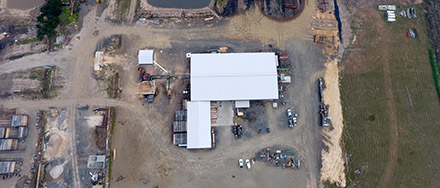An upbeat Radial Timber is looking to move into producing LVL from plantations and possibly process native forest ‘thinnings’ despite the planned closure of Victoria’s native forest industry by 2030. Source: Philip Hopkins for Timberbiz
Radial, which is based at Yarram in Victoria’s South Gippsland, aims to leverage its special ability to process small-diameter timber for a variety of uses.
The managing director, Chris McEvoy, set out his hopes during a presentation to a webinar ‘Victoria’s Production Forests – a way forward’, hosted by the Institute of Foresters/Australian Forest Growers.
Radial, which sources wood from VicForests, is in transition to process timber from its durable plantation hardwood species, using its radial technology that cuts timber in wedges like a cake. Mr McEvoy said radial sawing of small diameter logs, ‘thinnings’ and difficult timber was able to deal with growth stresses and create more timber that was also stabile. “Our ideal log size is 30-40cm, but we can process down to 25cm,” he said.
Mr McEvoy said Radial’s oldest plantation was 16 years old, but with further plantings, the company by 2030 would still be “five-to-ten years short” of being totally self-sufficient in timber. However, he had not given up on native forests despite the 2030 ban.
“I still think things will come out of that, or fire control for forest management – small diameter 12-25cm, small material that you can value-add,” he said.
The Executive Director, Forest and Fibre in the Department of Jobs, Precincts and Regions Nathan Trushell, told the webinar that post-2030, timber would come from management of the forest, such as thinning, roadside management and firebreaks. Small volumes would be available, he said, but “the broader forest management future is a matter for DELWP” (Department of the Environment, Land, Water and Planning). “We are linked with DELWP, but we are focussed on industry development,” he said.
Radial has received a $397,000 state grant to introduce a small log line and experiment with processing plantation timber. Mr McEvoy said this would allow the business to target farm forestry species such as spotted gum or yellow stringybark, but not in commercial volumes.
“We will look at look at the grain, recovery and finished products, to get a better understanding, when our trees are mature, to know how they will perform,” he said.
A second project would pay for a survey in Victoria to see how Radial could supplement its resource until its trees matured. “We need more wood fibre. Private forestry has not been looked at for some time and some agroforestry. We’ll see what’s around,” he said.
Mr McEvoy said the returns on thinning often did not cover the costs, but the small
log line would take thinnings from plantations closer to the mill. The worst would go to firewood, but the better would be peeled down to heartwood for use as organic fence posts or vineyards. “We are confident we can get organic non-treated posts to get good returns from thinnings,” he said.
Mr McEvoy said the company would put in its own money to build an LVL line to produce structural LVL. “This will be only the second LVL plant in Australia; there is a large one in Western Australia. We will be a boutique plant to supply structural LVL in shorter lengths for the construction market, which is crying out for material,” he said.
Also, Radial was close to establishing a bioenergy plant, a pyrolysis plant, to create heat and energy and valuable products – biochar, wood vinegar, biodiesel. “With thinnings, sawdust and shavings, we have a lot of wood fibre on site. We can start to become closed loop. The circular economy is a dream of mine, to be a benchmark for the future of the industry – something else quite exciting,” he said.
Radial Timber, only processing 12,000 cubic metres a year, was small, “not a mover and shaker”. “But we are lucky we can move and change to moving markets very quickly. I’m not happy about the 2030 decision, but it forces people to think differently. There is a lot of doom and gloom, but it’s important to get trees in the ground. They take 30-35 years to grow. Every year that goes past is another year lost,” he said.
“I can’t believe Australia, with so much land and so much technical knowledge, has been too long an importer of timber, particularly structural timber and LVL. It’s about time we were more independent and supply our own resource. We have the land, capability and knowledge.”






